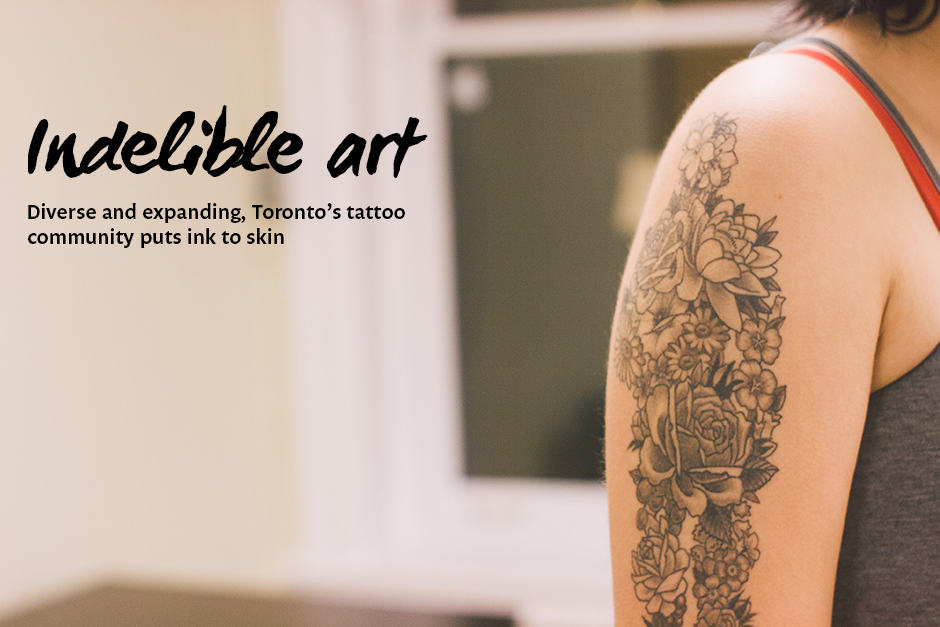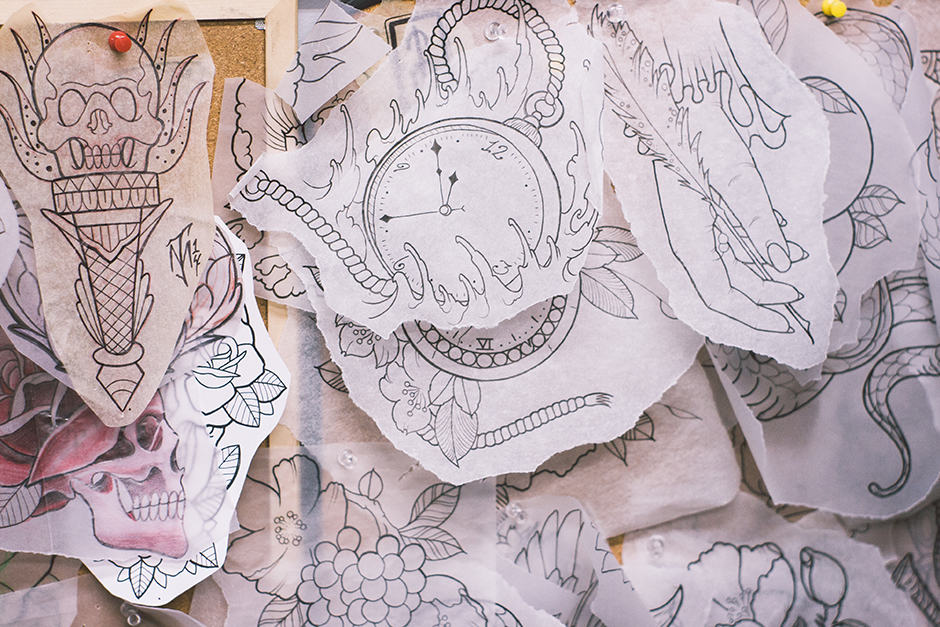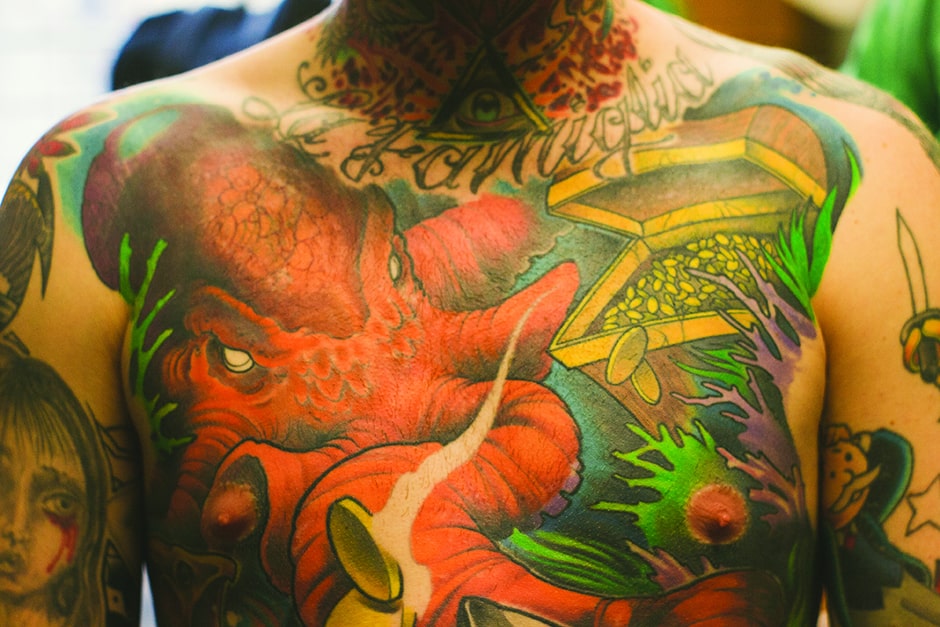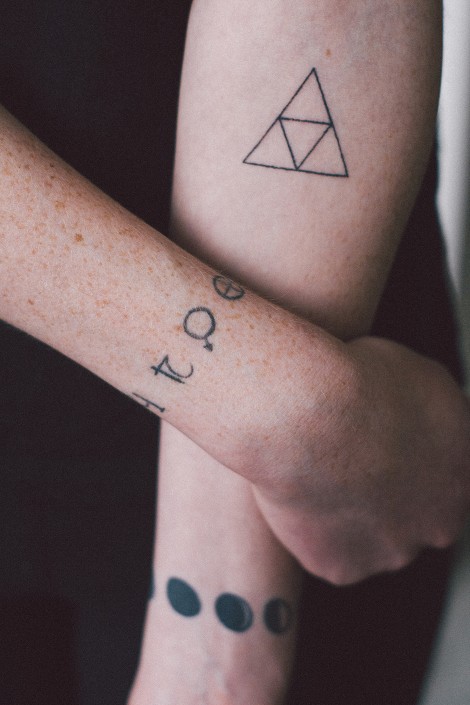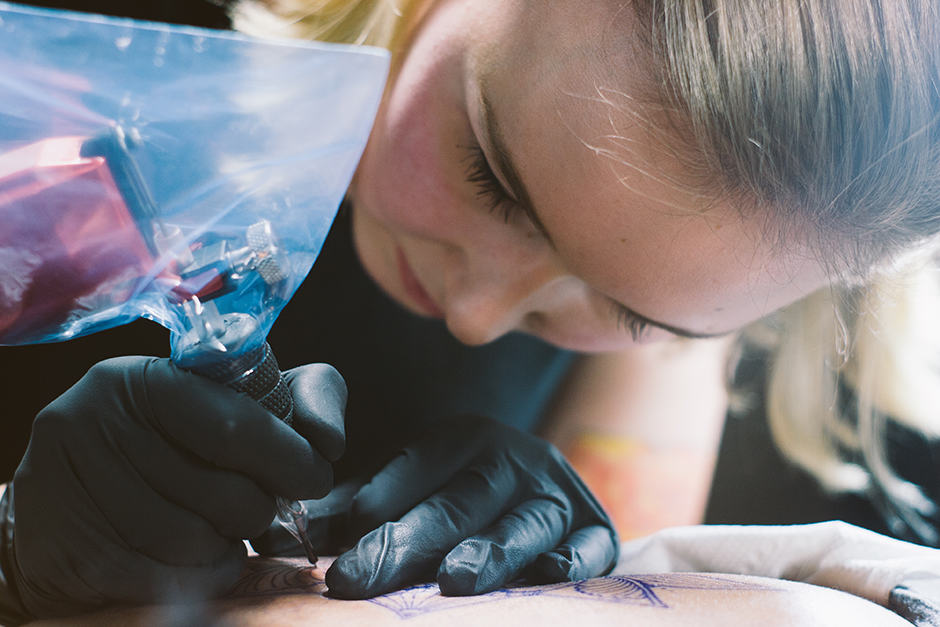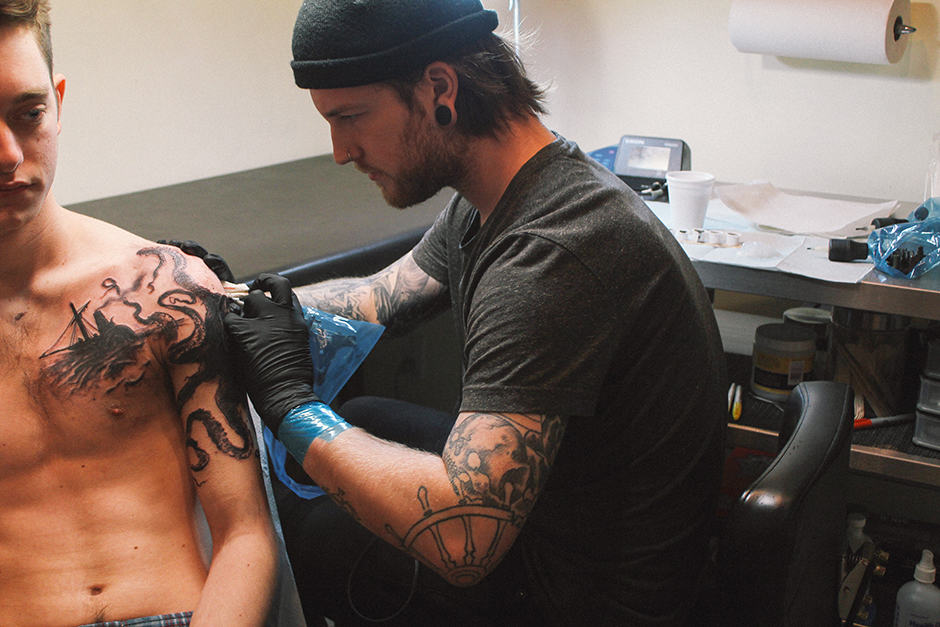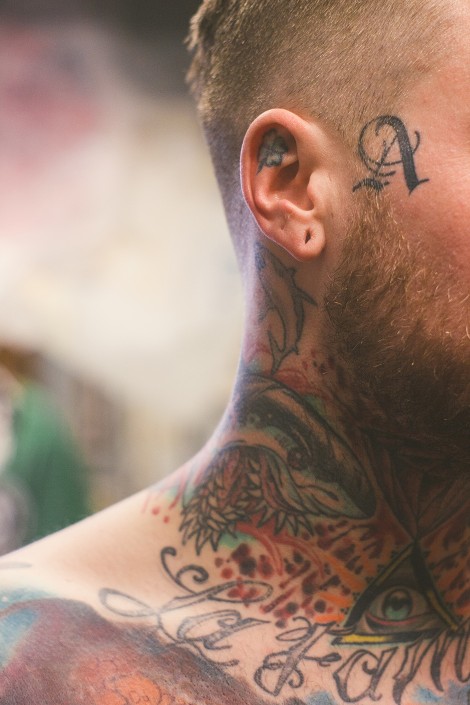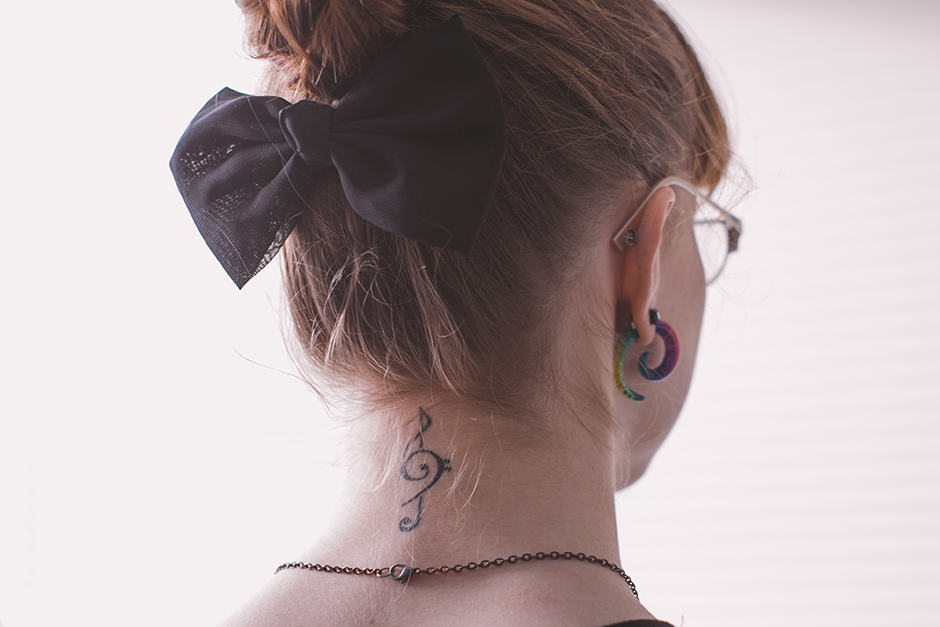Hidden beneath clothes and wrought on moving canvases, tattoos are perhaps one of the most common art forms in the city.
Toronto is a hub for tattoo aficionados, and behind the doors of the city’s many parlors is a diverse community of people-painters. Toronto’s tattoo scene is large and eclectic, with hundreds of shops, thousands of artists, and tens of thousands of tattooed people. Despite their relatively ubiquitous nature, a conversation with some of the city’s artists reveals the highly individualized nature of the art.
BEHIND THE ART
At one of the city’s most well-known shops, Adrenaline on Queen Street West, we were introduced to two of its 30-plus artists. Chris Price and Justin Murphy have been tattooing at Adrenaline for four and two years, respectively, but both began their tattoo careers outside of Toronto.
Price started his artistic career in Vancouver, but quickly moved here to take advantage of Toronto’s growing tattoo scene. Since his move, he has made a name for himself in the city, including being recently recognized by NOW Magazine as Toronto’s best tattoo artist.
When asked about the title, Price laughes, “I think that award has more to do with customer service than about artwork. I am talented, but so are many other artists in this town.”
Looking around his studio at the sketches on the wall, it is easy to disagree with him. His artistic style is motley and beautiful. Most of his work tends towards an illustrative style, but Price is adamant that, when it comes to style, he is a jack-of-all-trades — an epithet he believes helps him succeed and stand out as an artist.
“A lot of tattoo artists specialize in traditional style and that is where a lot of the competition is. I like to be good at whatever someone brings me. I enjoy a challenge. I don’t like to say ‘No, I can’t do that style’ because I could do that. I want to be able to cater to the clients as best I can,” he says.
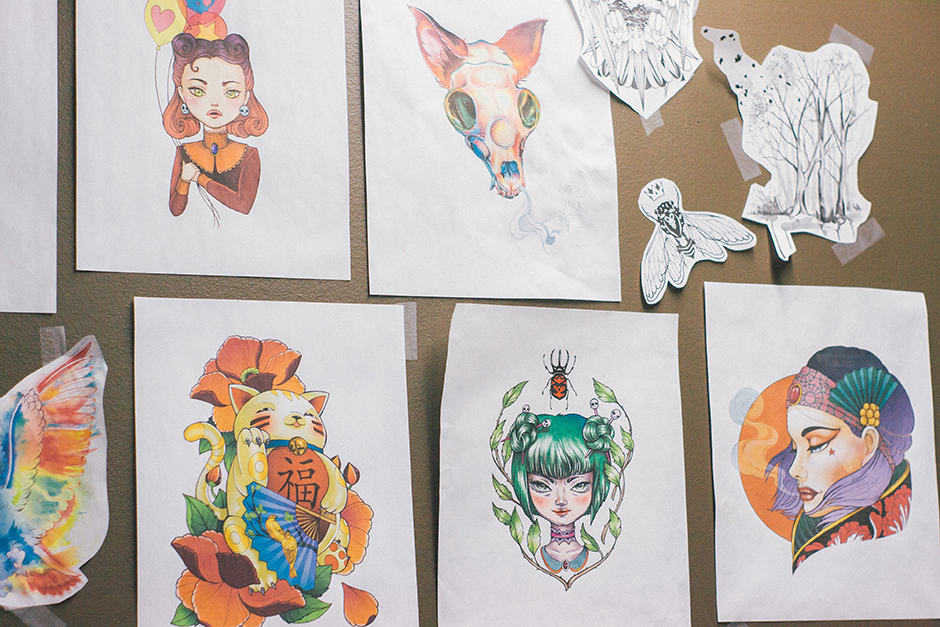
For Toronto’s tattoo artists, the craft is as much about ink as it is about art. JENNIFER SU/THE VARSITY
When asked about any restrictions he puts on himself when designing and inking tattoos, Price shows the same enthusiasm: “I don’t normally do super large pieces, but if I could take it on and want it in my portfolio then I will do it,” he says.
Murphy’s studio is located a couple of rooms away from that of Price. Murphy is an equally talented though more stylistically specialized artist who has been developing his craft since 2007. He began his career in Halifax but soon moved to Vancouver and then eventually Toronto to immerse himself in the heart of Canada’s tattoo culture. His geographic moves were calculated; Murphy wants his skills to be challenged.
“I like the competitive nature of Toronto. In Halifax it was not competitive because of the lack of shops. Nobody is forced to push or improve their craft to the next level because they have no competition. Meanwhile, in Toronto, you basically have to be on the top of your game because if you’re not, somebody is going to sweep the feet out from under you. Some people hate that; I enjoy it,” he says.
Murphy specializes in neo-traditional tattoos — bold, graphic, and elaborate types of designs that are gaining in popularity with tattoo collectors. This tattoo style is one of many new types of tattoo design that have emerged in the last decade.
Murphy attributes the proliferation and evolution of tattoo designs to things like changes in public perception through certain television shows and technological advances in tattooing equipment; however, the primary catalyst, he claims, is the recent infusion of fine arts and artists into the industry.
“With old-school traditional tattooing, a lot of the guys couldn’t draw to save their life. If they were battling for their soul in hell, they would stay where they were. Now, though, a lot of like painters and different fields of art have integrated into tattooing, especially in the last five years. Now that fine arts have merged with tattooing you can see everything kind of taking off,” he explains.
When asked why more artists prefer skin to canvas, Murphy simply states: “It’s more profitable, and more fun.”
Murphy started off as a painter but found that not only was tattooing more lucrative, it was also more rewarding. While he was in Halifax, Murphy worked with many women who had undergone mastectomies, tattooing nipples onto scar tissue and ultimately helping his customers recover from the trauma they had experienced.
Reconstructive surgery is one of the many ways tattooing has become more normalized in the public eye and has helped change the negative stigma it used to have.
“It has become more therapeutic than rebellious,” claims Murphy. “Tattoos are still about self expression but are a lot less ‘Fuck you.’”
SELF-EXPRESSION
About a 20-minute walk westward at Queen Street West and Ossington Avenue, there is a tattoo artist who disagrees.
“Tattoos are still inherently rebellious,” says Arthur Mills, an artist from Imperial Tattoos. “Different types of people are getting tattooed now but for the same reasons as before. They want to externalize an internal desire. To be more attractive, to express something, to remember an event or person in their lives,” he explains.
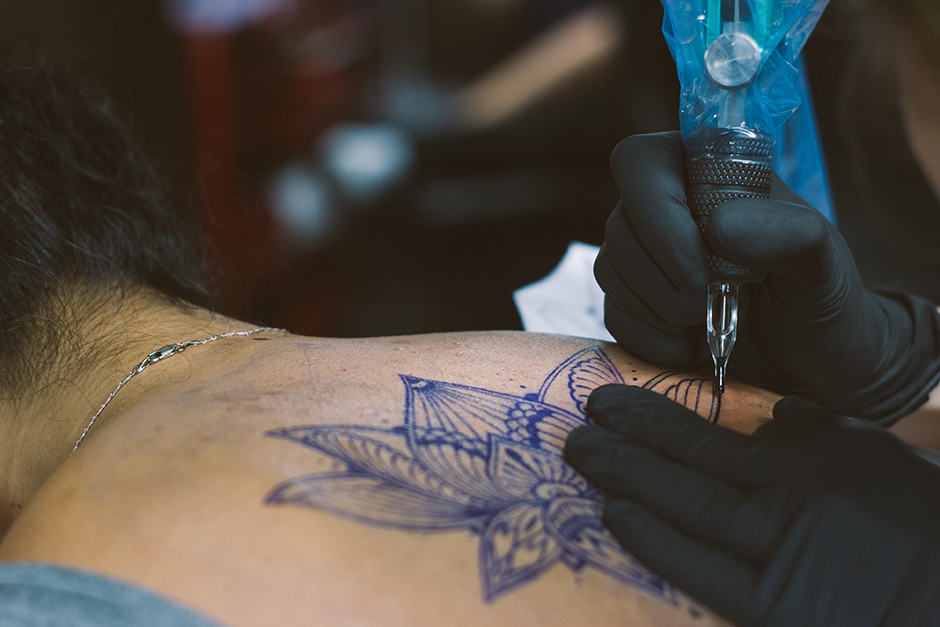
For Toronto’s tattoo artists, the craft is as much about ink as it is about art. JENNIFER SU/THE VARSITY
“It is done to make you feel a certain way or to make people see you in a certain way. Tattoo is still primarily about vanity,” Mills adds.
Mills is an American artist who has been tattooing in Toronto since 2006. He moved to the city to take advantage of its massive population of 20 to 35-year-olds, the prime demographic of tattooees.
The parlor he works in is not the standard walk-in tattoo shop, although they do accept walk-ins. Instead, Imperial is on the top level of a modest black-bricked building, giving it a more intimate feel. Mills says it is a more pleasant working environment.

First-year student Sidhi Srinivasachar had her tattoo designed by Tegan Rush. JENNIFER SU/THE VARSITY
“I worked briefly for a large tattoo shop on King Street a while back but found it to be too much. It was not the working atmosphere I felt I could be the most productive. Imperial provides that workspace. The stuff we do here is often large-scale and requires multiple sittings and a quiet environment. We elongate the conceptual process. We work at a relaxed pace,” he says.
It was indeed very relaxing. Jazz echoed through the large, open room that held four or five sectioned-off working areas for different artists. Mills’ section was plastered with sketches, displaying his inkling and talent for illustrative tattoo styles. Neighbouring him was an artist who preferred Japanese-style designs.
“We are a smaller studio, but we cover all the major styles of tattoos. We do a little bit of everything,” Mills says.
A CHANGING INDUSTRY
There is no doubt that Imperial is saturated with artistic talent, but due to their lack of advertising and hidden location, one wonders how the studio attracts customers.
“Most of our clients hear about us from word of mouth and social networking, but I would also attribute a large part of our success to repeat customers and a growth in the population of people wanting to get tattooed. Right now more people are getting tattooed than ever. Doctors, lawyers, and dentists come to me to get tattooed,” Mills says.
Mills, like many artists, attributes the growing interest in tattoos to the continuing advances in tattooing technology and, consequently, artistic skills. He also attributes the growth to the corporatization of tattoo art. Brands like Ed Hardy and Sailor Jerry Rum that use tattoo flash as part of their public image have helped push tattoos into the public realm.
“There is a lot of corporate interest in tattooing now, which brings more money into the industry. More money means more advances to technique and technology and more interest and time in the public eye,” he says.
There is a catch-22 in this situation. The corporatization of tattoo supplies is often managed by people who are not tattoo artists, yet they provide better technology and thus increase the possibilities for artistic expression by the actual tattoo artists.
“In general, tattoo artists try to avoid becoming too corporatized or commercialized. They want to keep the money in the industry, but with more money from corporations means better equipment available, which lights a fire under everyone’s feet and makes everyone more competitive,” says Mills.
Despite all the industry changes and increase in competition, Imperial has done well with their marketing strategy by focusing more on quality than quantity of artwork.
INDIVIDUAL ART
Adrenaline and Imperial are only two of the many types of tattoo studios that Toronto has to offer. Each of the city’s studios has its own niche.
U of T student Rosemary Webb prefers Chronic Ink on Yonge Street, where her best friend and one of Toronto’s leading female tattoo artists, Tegan Rush, tattoos her.
Webb is an avid tattoo collector, with seven so far and more soon to come. For her, getting tattooed is a very personal experience but also a bit of an addiction.
“I think my tattoos really represent my passions and are influenced by different aspects of my personality. Two are for my fascination with the universe and remind me every day of my dream to be an astrophysicist; one is for how important music is in my life, two more represent how much I love baking, tea, and all things cute; one is an homage to video games and geekdom; and one represents my heritage and where I grew up,” she explains.
Webb adds, “So yes, they all have some meaning behind them. I think that having meaning behind a tattoo is a great way to start, but now I simply want more art on my body.”
Tegan Rush has been tattooing at Chronic Ink for almost two years, completing her apprenticeship and then carrying on as one of the shop’s artists.
For her, the decision to become involved in the industry was as personal as it was about art. “I decided to go into tattooing in my grade 12 year of high school… It’s not something I would have necessarily thought of going into at the time, but people kept suggesting I look into it because my style fits well with tattoo design.”
It’s a decision she’s happy to have made. “It turn[ed] out to be a very good fit for me. You get a lot more artistic freedom than many arts jobs in larger industries like animation and illustration and interesting new projects every day,” she explains.
Knowing the motivation behind her clients’ desire for a tattoo is important to Rush. “I always ask a client if the tattoo they are getting has meaning to them or is just an image that they like,” she says.
The responses she receives are varied. “Some people need a very solid reason to get a tattoo, like a major event in their lives, a person they want to commemorate, or a passion they have. Others choose tattoos just for the sake of the art itself, just an image that they find interesting or fashionable,” says Rush.
Regardless of the rationale, tattoos are inherently personal. As Rush explains, “The imagery will inevitably reflect the style and taste of the person, as well as a general mood.”
THINK BEFORE YOU INK
Addictive as tattoos are, many artists suggest that they should be chosen carefully.
“Be careful when choosing an artist,” warns Price. “Look at reputation and portfolios and of course cleanliness.”
“It is not about cost and convenience, but about quality,” adds Murphy. “The worst thing you can do when getting your first tattoo is going to the nearest shop or the first shop that will take you. Research is key.”
As the lesson goes, cheap tattoos aren’t good and good tattoos aren’t cheap. But it is not only the price and the place one needs to take into consideration.
“Be careful choosing a design,” says Mills. “There are restrictions in the media. Just because it looks good on paper does not mean it will when contoured with your body. It also may not age well. Trust the artist. They know what they’re doing. Take your time and do your research.”
Fortunately for her, Webb has been a smart collector.
“I have thought deeply about the design, size, placement, and colour of each tattoo. I think that if you spend time thinking about what you want it would be hard to regret them,” she says, adding, “I will never regret mine because they truly are works of art and I will always be happy to be the walking canvas that I am.”

